Related Research Articles
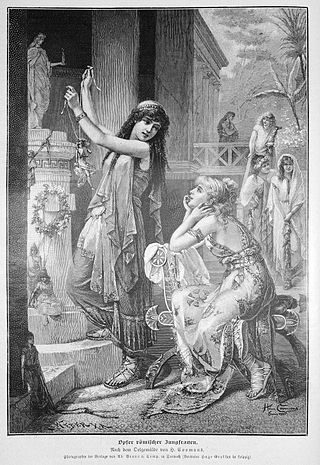
Paganism is a term first used in the fourth century by early Christians for people in the Roman Empire who practiced polytheism, or ethnic religions other than Judaism. In the time of the Roman Empire, individuals fell into the pagan class either because they were increasingly rural and provincial relative to the Christian population, or because they were not milites Christi. Alternative terms used in Christian texts were hellene, gentile, and heathen. Ritual sacrifice was an integral part of ancient Graeco-Roman religion and was regarded as an indication of whether a person was pagan or Christian. Paganism has broadly connoted the "religion of the peasantry".
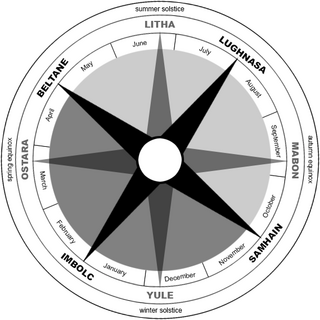
The Wheel of the Year is an annual cycle of seasonal festivals, observed by a range of modern pagans, marking the year's chief solar events and the midpoints between them. British neopagans crafted the Wheel of the Year in the mid-20th century, combining the four solar events marked by many European peoples, with the four seasonal festivals celebrated by Insular Celtic peoples. Different paths of modern Paganism may vary regarding the precise timing of each celebration, based on such distinctions as the lunar phase and geographic hemisphere.

The Norsemen were a North Germanic ethnolinguistic group of the Early Middle Ages, during which they spoke the Old Norse language. The language belongs to the North Germanic branch of the Indo-European languages and is the predecessor of the modern Germanic languages of Scandinavia. During the late eighth century, Scandinavians embarked on a large-scale expansion in all directions, giving rise to the Viking Age. In English-language scholarship since the 19th century, Norse seafaring traders, settlers and warriors have commonly been referred to as Vikings. Historians of Anglo-Saxon England distinguish between Norse Vikings (Norsemen) from Norway, who mainly invaded and occupied the islands north and north-west of Britain, as well as Ireland and western Britain, and Danish Vikings, who principally invaded and occupied eastern Britain.

The Geats, sometimes called Goths, were a large North Germanic tribe who inhabited Götaland in modern southern Sweden from antiquity until the Late Middle Ages. They are one of the progenitor groups of modern Swedes, along with Swedes and Gutes. The name of the Geats also lives on in the Swedish provinces of Västergötland and Östergötland, the western and eastern lands of the Geats, and in many other toponyms.

Swedish pre-history ends around 800 AD, when the Viking Age begins and written sources are available. The Viking Age lasted until the mid-11th century. Scandinavia was formally Christianized by 1100 AD. The period 1050 to 1350—when the Black Death struck Europe—is considered the Older Middle Ages. The Kalmar Union between the Scandinavian countries was established in 1397 and lasted until King Gustav Vasa ended it upon seizing power. The period 1350 to 1523 – when king Gustav Vasa, who led the unification of Sweden in the Swedish War of Liberation, was crowned – is considered the Younger Middle Ages. During these centuries, Sweden gradually consolidated as a single nation.

Olof Skötkonung, sometimes stylized as Olaf the Swede, was King of Sweden, son of Eric the Victorious and, according to Icelandic sources, Sigrid the Haughty. He succeeded his father in c. 995. He stands at the threshold of recorded history, since he is the first Swedish ruler about whom there is substantial knowledge. He is regarded as the first king known to have ruled both the Swedes and the Geats. In Sweden, the reign of king Olov Skötkonung is considered to be the transition from the Viking age to the Middle Ages, because he was the first Christian king of the Swedes, who were the last to adopt Christianity in Scandinavia. He is associated with a growing influence of the church in what is today southwestern and central Sweden. Norse beliefs persisted in parts of Sweden until the 12–13th century.
In Germanic paganism, a seeress is a woman said to have the ability to foretell future events and perform sorcery. They are also referred to with many other names meaning "prophetess", "staff bearer", "wise woman" and "sorceress", and they are frequently called witches or priestesses both in early sources and in modern scholarship. In Norse mythology the seeress is usually referred to as völva or vala.

Veleda was seeress of the Bructeri, a Germanic people who achieved some prominence during the Batavian rebellion of AD 69–70, headed by the Romanized Batavian chieftain Gaius Julius Civilis, when she correctly predicted the initial successes of the rebels against Roman legions.
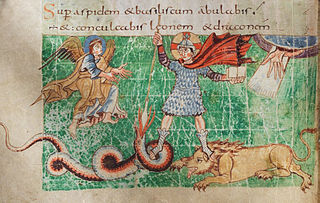
The Germanic peoples underwent gradual Christianization in the course of late antiquity and the Early Middle Ages. By AD 700, England and Francia were officially Christian, and by 1100 Germanic paganism had also ceased to have political influence in Scandinavia.
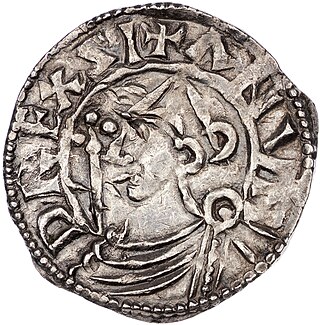
Anund Jacob or James was King of Sweden from 1022 until around 1050. He is believed to have been born on 25 July, in either 1008 or 1010 as Jakob, the son of King Olof Skötkonung and Queen Estrid. Being the second Christian king of the Swedish realm, his long and partly turbulent reign saw the increasing dissemination of Christianity as well as repeated attempts to influence the balance of power in Scandinavia. Throughout his reign, he tried to subvert the rising Danish hegemony in Scandinavia by supporting the Norwegian monarchy. He also supported the reign of Yaroslav the Wise in Kievan Rus, his brother-in-law. He is referred to in positive terms in German and Norse historical sources. His reign was one of the longest in Sweden during the Viking Age and Middle Ages.
The mythologies in present-day France encompass the mythology of the Gauls, Franks, Normans, Bretons, and other peoples living in France, those ancient stories about divine or heroic beings that these particular cultures believed to be true and that often use supernatural events or characters to explain the nature of the universe and humanity. French myth has been primarily influenced by the myths and legends of the Gauls and the Bretons as they migrated to the French region from modern day England and Ireland. Other smaller influences on the development of French mythology came from the Franks.
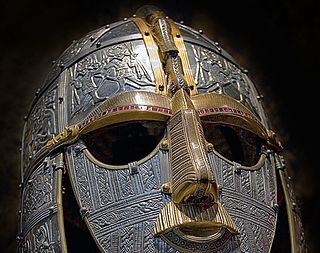
Anglo-Saxon paganism, sometimes termed Anglo-Saxon heathenism, Anglo-Saxon pre-Christian religion, or Anglo-Saxon traditional religion, refers to the religious beliefs and practices followed by the Anglo-Saxons between the 5th and 8th centuries AD, during the initial period of Early Medieval England. A variant of Germanic paganism found across much of north-western Europe, it encompassed a heterogeneous variety of beliefs and cultic practices, with much regional variation.
Gothic Christianity refers to the Christian religion of the Goths and sometimes the Gepids, Vandals, and Burgundians, who may have used the translation of the Bible into the Gothic language and shared common doctrines and practices.

The Christianization of Scandinavia, as well as other Nordic countries and the Baltic countries, took place between the 8th and the 12th centuries. The realms of Denmark, Norway and Sweden established their own archdioceses, responsible directly to the pope, in 1104, 1154 and 1164, respectively. The conversion to Christianity of the Scandinavian people required more time, since it took additional efforts to establish a network of churches.

The Livonian crusade consists of the various military Christianisation campaigns in medieval Livonia – modern Latvia and Estonia – during the Papal-sanctioned Northern Crusades in the 12–13th century. The Livonian crusade was conducted mostly by the Holy Roman Empire and the Kingdom of Denmark. It ended with the creation of Terra Mariana and the Danish duchy of Estonia. The lands on the eastern shores of the Baltic Sea were one of the last parts of Europe to be Christianised.

Paganism is commonly used to refer to various religions that existed during Antiquity and the Middle Ages, such as the Greco-Roman religions of the Roman Empire, including the Roman imperial cult, the various mystery religions, religions such as Neoplatonism and Gnosticism, and more localized ethnic religions practiced both inside and outside the empire. During the Middle Ages, the term was also adapted to refer to religions practiced outside the former Roman Empire, such as Germanic paganism, Egyptian paganism and Baltic paganism.

The North Sea Empire, also known as the Anglo-Scandinavian Empire, was the personal union of the kingdoms of England, Denmark and Norway for most of the period between 1013 and 1042 towards the end of the Viking Age. This ephemeral Norse-ruled empire was a thalassocracy, its components only connected by and dependent upon the sea.
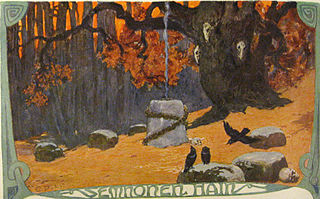
Ganna was a Germanic seeress, of the Semnoni tribe, who succeeded the seeress Veleda as the leader of a Germanic alliance in rebellion against the Roman Empire. She went together with her king Masyus as envoys to Rome to discuss with Roman emperor Domitian himself, and was received with honours, after which she returned home. She is only mentioned by name in the works of Cassius Dio, but she also appears to have provided posterity with select information about the religious practices and the mythology of the early Germanic tribes, through the contemporary Roman historian Tacitus who wrote them down in Germania. Her name may be a reference to her priestly insignia, the wand, or to her spiritual abilities, and she probably taught her craft to Waluburg who would serve as a seeress in Roman Egypt at the First Cataract of the Nile.
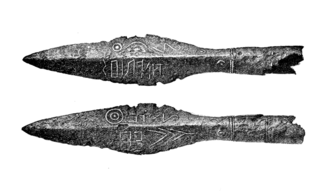
Gothic paganism was the original religion of the Goths before their conversion to Christianity.
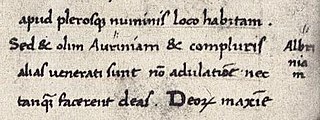
Albruna, Aurinia or Albrinia are some of the forms of the name of a probable Germanic seeress who would have lived in the late 1st century BC or in the early 1st century AD. She was mentioned by Tacitus in Germania, after the seeress Veleda, and he implied that the two were venerated because of true divine inspiration by the Germanic peoples, in contrast to Roman women who were fabricated into goddesses. It has also been suggested that she was the frightening giant woman who addressed the Roman general Drusus in his own language and made him turn back at the Elbe, only to die shortly after, but this may also be an invention to explain why a consul of Rome would have turned back. In addition, there is so little evidence for her that not every scholar agrees that she was a seeress, or that she should be included in a discussion on them. She may also have been a minor goddess, a matron.